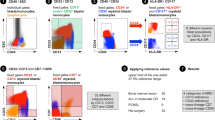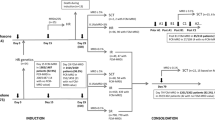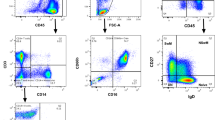Abstract
An early appreciation of treatment efficacy could be very useful in acute myeloblastic leukemia (AML), and a prognostic value has been suggested for the morphological assessment of decrease in blasts during induction therapy. More sensitive, multiparametric flow cytometry (FCM) can detect far lower blast counts, allowing for a precise and reliable calculation of blast cell decrease rate (BDR). Such a multiparametric FCM four-colours/single-tube protocol, combining CD11b, CD45-ECD and CD16-PC5, was applied to peripheral blood samples from 130 AML patients, collected daily during induction chemotherapy. Normalized blast cell percentages were used to calculate the relevant decrease slopes. Slope thresholds (<−25, −25 to −15 and >−15), or the time required to reach 90% depletion of the peripheral blast load (<5, 5 or >5 days), was strongly associated with the achievement of complete remission (P<0.0001). Log-rank test and Cox model showed that they also carried high statistical significance (P<0.0001) for disease-free survival. The prognostic value of cytogenetic features, confirmed in this series, was refined by BDR, which allowed to discriminate between good- and poor-risk patients among those with intermediate or normal karyotypes. This simple FCM protocol allows for an accurate prognostic sequential approach adapted to the determination of decrease in peripheral blast cells during induction chemotherapy.
This is a preview of subscription content, access via your institution
Access options
Subscribe to this journal
Receive 12 print issues and online access
$259.00 per year
only $21.58 per issue
Buy this article
- Purchase on Springer Link
- Instant access to full article PDF
Prices may be subject to local taxes which are calculated during checkout




Similar content being viewed by others
References
Estey E, Dohner H . Acute myeloid leukaemia. Lancet 2006; 368: 1894–1907.
Krug U, Serve H, Muller-Tidow C, Mesters RM, Steffen B, Buchner T et al. New molecular therapy targets in acute myeloid leukemia. Recent Results Cancer Res 2007; 176: 243–262.
Béné MC, Bernier M, Casasnovas RO, Castoldi G, Doekharan D, van der Holt B et al. Acute myeloid leukaemia M0: haematological, immunophenotypic and cytogenetic characteristics and their prognostic significance: an analysis in 241 patients. Br J Haematol 2001; 113: 737–745.
Casasnovas RO, Campos L, Mugneret F, Charrin C, Bene MC, Garand R et al. Immunophenotypic patterns and cytogenetic anomalies in acute non-lymphoblastic leukemia subtypes: a prospective study of 432 patients. Leukemia 1998; 12: 34–43.
Steffen B, Muller-Tidow C, Schwable J, Berdel WE, Serve H . The molecular pathogenesis of acute myeloid leukemia. Crit Rev Oncol Hematol 2005; 56: 195–221.
Vardiman JW, Harris NL, Brunning RD . The World Health Organization (WHO) classification of the myeloid neoplasms. Blood 2002; 100: 2292–2302.
Gajjar A, Ribeiro R, Hancock ML, Rivera GK, Mahmoud H, Sandlund JT et al. Persistence of circulating blasts after one week of multiagent chemotherapy confers a poor prognosis in childhood acute lymphoblastic leukemia. Blood 1995; 86: 1262–1295.
Wheatley K, Burnett AK, Goldstone AH, Gray RG, Hann IM, Harrison CJ et al. A simple, robust, validated and highly predictive index for the determination of risk-directed from the MRC AML 10 trial. Br J Haematol 1999; 10: 69–79.
Kern W, Haferlach T, Schoch C, Löffler H, Gassmann W, Heinecke A et al. Early blast clearance by remission induction therapy is a major independent prognostic factor for both achievement of complete remission and long-term outcome in acute myeloid leukemia: data from the German AML Cooperative Group (AMLCG) 1992. Trial. Blood 2003; 101: 64–70.
Browman G, Preisler H . Predicting remission outcome in acute non-lymphoblastic leukemia: general principles and their application to residual marrow leukemia. Leuk Res 1992; 16: 511–519.
Kern W, Schoch C, Haferlach T, Schnittger S . Monitoring of minimal residual disease in acute myeloid leukemia. Crit Rev Oncol Hematol 2005; 56: 283–309.
Maurillo L, Buccisano F, Spagnoli A, Del Poeta G, Panetta P, Neri B et al. Monitoring of minimal residual disease in adult acute myeloid leukemia using peripheral blood as an alternative source to bone marrow. Haematologica 2007; 92: 605–611.
San Miguel JF, Vidriales MB, López-Berges C, Díaz-Mediavilla J, Gutiérrez N, Cañizo C et al. Early immunophenotypical evaluation of minimal residual disease in acute myeloid leukemia identifies different patient risk groups and may contribute to postinduction treatment stratification. Blood 2001; 98: 1746–1751.
Lioure B, Delaunay J, Blaise D, Milpied N, Guardiola P, Cahn JY et al. Allogeneic stem cell transplantation (SCT) with non myeloablative conditioning regimen (NST) following intensive consolidation may be equivalent to conventional alloSCT and superior to autoSCT for patients over 50 with acute myeloid leukemia (AML) in 1st CR: first results of the AML 2001 trial. Blood (ASH Annual Meeting Abstracts) 2006; 108: 319.
Pigneux A, Himberlin C, Hunault-Berger M, Witz F, Recher C, Harousseau JL et al. Amulticenter randomized comparison of maintenance treatment with androgens in elderly acute myeloid leukemia after ICL regimen as induction therapy: results of the Goelams-2002 Study. Blood (ASH Annual Meeting Abstracts) 2006; 108: 1983.
Cheson BD, Bennett JM, Kopecky KJ, Büchner T, Willman CL, Estey EH et al. International Working Group for Diagnosis, Standardization of Response Criteria, Treatment Outcomes, and Reporting Standards for Therapeutic Trials in Acute Myeloid Leukemia. Revised recommendations of the International Working Group for Diagnosis, Standardization of Response Criteria, Treatment Outcomes, and Reporting Standards for Therapeutic Trials in Acute Myeloid Leukemia. J Clin Oncol 2003; 21: 4642–4649.
Fujimoto H, Sakata T, Hamaguchi Y, Shiga S, Tohyama K, Ichiyama S et al. Flow cytometric method for enumeration and classification of reactive immature granulocyte populations. Cytometry 2000; 42: 371–378.
Hubl W, Tlustos L, Erath A, Andert S, Bayer PM . Proposed reference method for peripheral-blood monocyte counting using fluorescence-labelled monoclonal antibodies. Cytometry 1996; 26: 69–74.
Lacombe F, Durrieu F, Briais A, Dumain P, Belloc F, Bascans E et al. Flow cytometry CD45 gating for immunophenotyping of acute myeloid leukemia. Leukemia 1997; 11: 1878–1886.
Mrozek K, Bloomfield CD . Chromosome aberrations, gene mutations and expression changes, and prognosis in adult acute myeloid leukemia. Hematology Am Soc Hematol Educ Program 2006; 2006: 169–177.
Peto J . The calculation and interpretation of survival curves. In: Buyse ME, Staquet MJ, Sylvester RJ (eds). Cancer Clinical Trials: Methods and Practice. Oxford University Press: Oxford, England, 1984, pp 361–380.
Breslow N . Comparison of survival curves. In: Buyse ME, Staquet MJ, Sylvester RJ (eds). Cancer Clinical Trials: Methods and Practice. Oxford University Press: Oxford England, 1984, pp 381–406.
Cox DR . Regression models and life-tables. J R Soc Stat [B] 1972; 34: 187–220.
Elliott MA, Litzow MR, Letendre LL, Wolf RC, Hanson CA, Tefferi A et al. Early peripheral blood blast clearance during induction chemotherapy for acute myeloid leukemia predicts superior relapse-free survival. Blood 2007; 110: 4172–4174.
Rumke CL . Variability of results in differential counts on blood smears. Triangle, The Sandoz Journal of Medical Science. 1960; 4: 156.
Slovak ML, Kopecky KJ, Cassileth PA, Harrington DH, Theil KS, Mohamed A et al. Karyotypic analysis predicts outcome of preremission and postremission therapy in adult acute myeloid leukemia: a Southwest oncology Group/Eastern Cooperative Oncology Group study. Blood 2000; 96: 4075–4083.
Grimwade D, Walker H, Harrison G, Oliver F, Chatters S, Harrison CJ et al. Medical Research Council Adult Leukemia Working Party. The predictive value of hierarchical cytogenetic classification in older adults with acute myeloid leukemia (AML): analysis of 1065 patients entered into the United Kingdom Medical Research Council AML11 trial. Blood 2001; 98: 1312–1320.
Marcucci G, Mrozek K, Ruppert AS, Archer KJ, Pettenati MJ, Heerema NA et al. Abnormal cytogenetics at date of morphologic complete remission predicts short overall and disease-free survival, and higher relapse rate in adult acute myeloid leukemia: results from cancer and leukemia group B study 8461. J Clin Oncol 2004; 22: 2410–2418.
Acknowledgements
We are grateful to Professors Norbert Ifrah (Angers), Jean Yves Cahn (Grenoble) and Francis Belloc (Bordeaux) for fruitful discussion, Alex Briais (Bordeaux) and Marie Robert (Bordeaux) for helpful technical assistance and to cytogeneticists, respectively Drs Marina Lafage Pochitaloff and Joëlle Mozziconacci (Marseille), Francine Mugneret (Dijon) and Marie Josée Grégoire (Vandoeuvre les Nancy). This work benefited grants from the Goelams group, Fondation de France and Laurette Fugain association.
Author information
Authors and Affiliations
Corresponding author
Rights and permissions
About this article
Cite this article
Lacombe, F., Arnoulet, C., Maynadié, M. et al. Early clearance of peripheral blasts measured by flow cytometry during the first week of AML induction therapy as a new independent prognostic factor: a GOELAMS study. Leukemia 23, 350–357 (2009). https://doi.org/10.1038/leu.2008.296
Received:
Revised:
Accepted:
Published:
Issue Date:
DOI: https://doi.org/10.1038/leu.2008.296
Keywords
This article is cited by
-
Peripheral blood minimal/measurable residual disease assessed in flow cytometry in acute myeloblastic leukemia
Leukemia (2019)
-
Effect of measurable (‘minimal’) residual disease (MRD) information on prediction of relapse and survival in adult acute myeloid leukemia
Leukemia (2016)
-
Clinical significance of day 5 peripheral blast clearance rate in the evaluation of early treatment response and prognosis of patients with acute myeloid leukemia
Journal of Hematology & Oncology (2015)
-
Effect of genetic profiling on prediction of therapeutic resistance and survival in adult acute myeloid leukemia
Leukemia (2015)
-
Resistance prediction in AML: analysis of 4601 patients from MRC/NCRI, HOVON/SAKK, SWOG and MD Anderson Cancer Center
Leukemia (2015)



